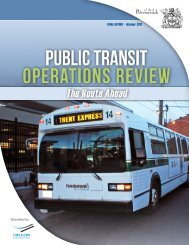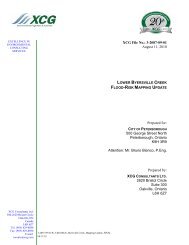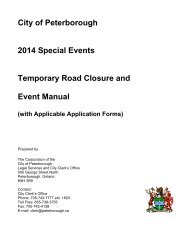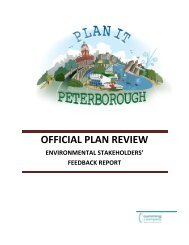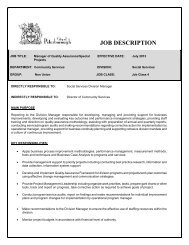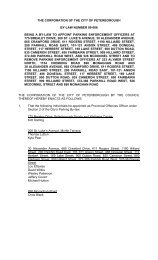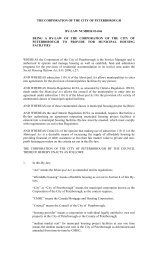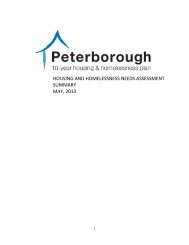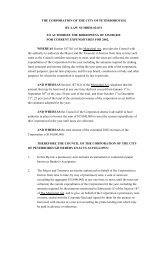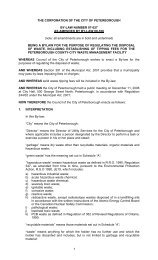Thompson Creek Flood Study Report - City of Peterborough
Thompson Creek Flood Study Report - City of Peterborough
Thompson Creek Flood Study Report - City of Peterborough
You also want an ePaper? Increase the reach of your titles
YUMPU automatically turns print PDFs into web optimized ePapers that Google loves.
<strong>Thompson</strong> <strong>Creek</strong> Detailed <strong>Flood</strong> Reduction <strong>Study</strong><br />
<strong>City</strong> <strong>of</strong> <strong>Peterborough</strong><br />
4.4.1.2 Model Verification<br />
Model verification consisted <strong>of</strong> simulating the flows from a measured rainfall event<br />
from the monitoring period and comparing the results with measured flows in the creek<br />
and at the outlet from the storm sewer system at the intersection <strong>of</strong> Scollard Drive and<br />
Francis Stewart Road. The event selected occurred at about 2:00 am on June 1, 2006.<br />
According to the rainfall gauge located at <strong>City</strong> Hall, about 30 mm <strong>of</strong> rainfall fell in<br />
about 3 hours. This is approximately a 1 in 2 year rainfall for that duration. In contrast,<br />
the rainfall gauge at Trent University (about 2.5 km north <strong>of</strong> the area) recorded only<br />
about 4 mm <strong>of</strong> rain. At the outlet from the sewer system, a flow <strong>of</strong> 0.75 m 3 /s was<br />
recorded. This is theoretically at or slightly above the capacity <strong>of</strong> the outlet pipe at that<br />
location. Hence this was a significant event which produced a run<strong>of</strong>f volume <strong>of</strong> about<br />
22 mm that is consistent with the observed rainfall at <strong>City</strong> Hall. The storm must have<br />
been a localized event which passed through downtown and the study area but did not<br />
reach as far north as the University. Hence the <strong>City</strong> Hall rainfall was used in the<br />
simulation. Interestingly, as previously discussed in Section 4.2.3, the flow recorded at<br />
the instream gauge near the corner <strong>of</strong> Ashdale Crescent West was only about 0.3 m 3 /s.<br />
Theoretically, the flow downstream should be greater than upstream given the greater<br />
drainage area. However, there appears to be significant overbank storage in the area<br />
upstream <strong>of</strong> Armour Road (see for example, the discussion on Reach No. 2 in Section<br />
4.2.3) which reduces the downstream flows. A similar “damped” response was<br />
observed at this gauge for all other significant rainfalls during the monitoring period.<br />
Only the normal seepage <strong>of</strong> flow through the <strong>Thompson</strong> <strong>Creek</strong> Dam was measured at<br />
the upstream gauge, i.e. no flow spilled over the stop logs in the dam.<br />
The results <strong>of</strong> the simulation <strong>of</strong> the verification event are summarized in Table 4.4.3.<br />
As indicated, the outflow from subcatchment 11, is equivalent to the outflow from the<br />
Scollard/Francis Stewart outfall flow. The observed and simulated flows match very<br />
closely. The flow at the downstream gauge point also matches closely since a storage<br />
element was added to the model just upstream <strong>of</strong> Armour Road. This required about<br />
1,900 m 3 <strong>of</strong> storage. A review <strong>of</strong> the overbank topography in the area indicated that<br />
this amount <strong>of</strong> storage is available in the riparian area and its utilization would be<br />
promoted by the presence <strong>of</strong> a number <strong>of</strong> small dam structures which obstruct the creek.<br />
The model output is included in Appendix G.<br />
Based upon this close correspondence <strong>of</strong> observed and simulated flows for this<br />
significant event, the model was judged to satisfactorily represent the hydrologic<br />
response <strong>of</strong> <strong>Thompson</strong> <strong>Creek</strong>. The model parameters adopted were those originally<br />
estimated from the physiographic data as shown in Tables 4.4.1 and 4.4.2. No other<br />
flows <strong>of</strong> significance were found in the flow record from the gauge near the outlet <strong>of</strong><br />
14-06605-01-W01 <strong>City</strong> <strong>of</strong> <strong>Peterborough</strong> 48




